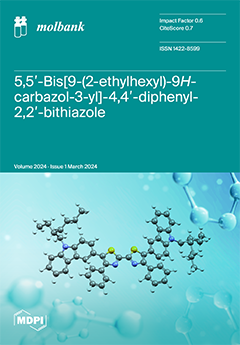The title compound
N-(2,4-difluorophenyl)-2-fluorobenzamide (
Fo24) was synthesized in high yield (1.09 g; 87%) using standard synthetic procedures from the condensation reaction of 2-fluorobenzoyl chloride with 2,4-difluoroaniline. Crystals of
Fo24 were grown from CH
2Cl
2 at room temperature. The
[...] Read more.
The title compound
N-(2,4-difluorophenyl)-2-fluorobenzamide (
Fo24) was synthesized in high yield (1.09 g; 87%) using standard synthetic procedures from the condensation reaction of 2-fluorobenzoyl chloride with 2,4-difluoroaniline. Crystals of
Fo24 were grown from CH
2Cl
2 at room temperature. The
Fo24 crystal structure was determined using single-crystal X-ray diffraction methods at 294 (1) K in space group
Pn (No. 7).
Fo24 is the second regular tri-fluorinated benzamide with the formula C
13H
8F
3N
1O
1 to be reported and contrasts with the more common difluorinated and tetra-fluorinated analogues. In
Fo24, both aromatic rings are effectively coplanar with an interplanar angle of 0.7(2)°. The central amide group plane is oriented by 23.04(18)° and 23.69(17)° from both aromatic rings, forming an intramolecular contact with an
ortho-F12 atom with H1⋯F12 = 2.12(4) Å. The primary hydrogen bonds are 1D amide–amide interactions that form along the
b-axis direction. In addition, weaker C-H⋯F/O interactions are noted: a
R22(12) synthon involving two C-H, a N-H and two C-F groups, with C-F⋯C ring–ring stacking contacts completing the interactions.
Full article





